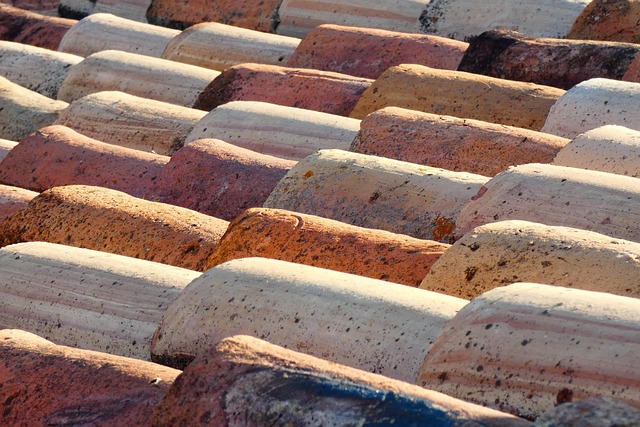Low slope roofing is a popular choice for commercial buildings like warehouses due to its flat surface and structural benefits. Key components include durable membranes (EPDM, TPO), underlayments, and flashings that protect against weather. Installation involves meticulous preparation, membrane application, drainage systems, and regular inspections. Proper maintenance, including roof cleaning and repairs, extends the life of these systems. Low slope roofing offers cost savings, aesthetics, and energy efficiency, making it a sustainable option for commercial spaces.
Low slope roofing, a prevalent choice for warehouses and large commercial buildings, offers a distinct aesthetic and functional advantage. This type of roofing system, characterized by its shallow pitch, presents an efficient solution for space optimization. In this comprehensive guide, we’ll explore the fundamentals of low slope roofing, from understanding its basic principles to delving into popular applications in the commercial sector. By shedding light on common materials, installation processes, and maintenance tips, we aim to equip readers with valuable insights into this game-changing roofing option.
- Understanding Low Slope Roofing Basics
- Common Materials Used in Construction
- Advantages and Disadvantages Compared to Steep Roofs
- Installation Process: Step-by-Step Overview
- Maintenance Requirements for Longevity
- Popular Applications in Commercial Spaces
Understanding Low Slope Roofing Basics

Low slope roofing is a common feature in many commercial buildings, particularly warehouses and large-scale industrial spaces. Unlike sloped roofs that have a steep angle for water runoff, low pitch roofs have a gentle slope, making them more suitable for flat or slightly curved surfaces. This design plays a crucial role in the structural integrity and longevity of these structures, as it allows for efficient roof drainage systems and reduces the risk of water damage.
Understanding the basics of low slope roofing involves grasping key components such as membranes, underlayments, and flashings. These elements work together to protect the building’s interior from adverse weather conditions. The gentle slope also influences the choice of materials, with options like EPDM (Ethylene Propylene Diene Monomer) and TPO (Thermoplastic Olefin) being popular for their durability and resistance to tears and punctures. With proper installation and regular maintenance, low pitch roofs offer a cost-effective and efficient solution for commercial roofing needs.
Common Materials Used in Construction

In the realm of commercial roofing, low slope or shallow-pitched roofs are a prevalent feature in warehouses and large-scale industrial buildings. These structures often employ specific materials tailored to handle the unique demands of such systems. Commonly used materials include high-performance membranes, such as EPDM (Ethylene Propylene Diene Monomer) and TPO (Thermoplastic Olefin), which offer exceptional durability and resistance to extreme weather conditions. These membranes are known for their ability to maintain integrity over extended periods, making them a preferred choice for low slope roofing applications.
Additionally, metal panels and shingles are popular for their versatility and long-lasting performance. Stainless steel, aluminum, and zinc alloys are frequently utilized due to their corrosion resistance and aesthetic appeal. The design of these low pitch roofs often incorporates advanced roof drainage systems to manage water flow efficiently, preventing potential damage caused by ponding or standing water. This is a critical aspect of maintaining the structural integrity of such buildings over time.
Advantages and Disadvantages Compared to Steep Roofs

Low slope roofing systems, common in warehouses and large commercial spaces, offer several advantages over steeper sloped roofs. Firstly, they are easier and faster to install, reducing construction time and costs. Moreover, their shallow pitch allows for simpler and lighter structural support, making them more cost-effective from a material standpoint. These systems also require less maintenance, as there is less risk of damage from snow or ice accumulation, and roof leaks are typically easier to identify and repair.
However, low slope roofs do have their drawbacks. They are more susceptible to wind damage and can gather more debris like leaves and branches, necessitating regular cleaning. Additionally, without proper drainage systems, water pooling on a low pitch roof can lead to structural issues over time. Despite these challenges, the right sloped roof design and efficient roof drainage systems remain essential considerations for maintaining the longevity and integrity of commercial buildings equipped with low slope roofing.
Installation Process: Step-by-Step Overview

The installation process for low slope roofing systems, commonly found in warehouses and large commercial spaces, involves several precise steps to ensure optimal performance and longevity. It starts with thorough preparation of the substrate, including cleaning and repairing any damage. A waterproof membrane is then applied as a protective layer, followed by the installation of insulation to enhance energy efficiency.
Next, the low pitch roof structure is assembled, incorporating roof drainage systems for effective water management. This involves fitting the appropriate trusses or supports, ensuring proper spacing and alignment. The actual roofing material—typically a durable, weather-resistant membrane—is then carefully unrolled and secured at overlapping joints with specialized fasteners. Regular inspection throughout the process guarantees any issues are addressed promptly, leading to a robust final installation that mirrors the sleek lines of a sloped roof design while maintaining functionality and safety.
Maintenance Requirements for Longevity

Low slope roofing systems, common in warehouses and large commercial spaces, require regular maintenance to ensure their longevity. Unlike sloped roofs with steeper angles, which naturally shed debris and water, low pitch roofs demand more attention to prevent water buildup and potential damage. Effective roof drainage systems are crucial for directing water away from the structure, preventing ponding, and reducing the risk of leaks and structural compromise over time.
Regular inspections should be conducted to identify any signs of wear or damage, such as missing or damaged shingles, flashing issues, or mold growth. Timely repairs, including replacing worn-out components and sealing areas prone to seepage, are essential for maintaining the integrity of the low slope roof. Additionally, applying protective coatings can enhance the roof’s durability by shielding it from environmental elements, further extending its lifespan.
Popular Applications in Commercial Spaces

Low slope roofing is a popular choice for commercial spaces, particularly in warehouses and large-scale industrial buildings. Its application is driven by the need for efficient and cost-effective solutions that can withstand heavy loads while offering long-term durability. This type of roofing system is well-suited for such environments due to its ability to provide a seamless, flat surface, which is ideal for accommodating various equipment and machinery often found in these spaces.
One of the key advantages of low slope roofs is their versatility when it comes to design and functionality. They can be easily incorporated into the overall architectural aesthetics while also housing essential components such as roof drainage systems. Unlike steeper sloped roofs, low pitch designs require less energy for heating and cooling, making them an eco-friendly option that contributes to reduced operational costs. This makes them a preferred choice for businesses seeking sustainable and efficient solutions for their commercial properties.
